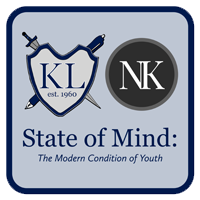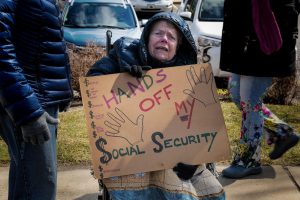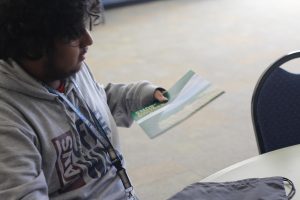When teachers intervene in fights, their students feel the consequences
Credit: Ari’el Abbott
March 16, 2022
 Editor’s note: This story is part of “State of Mind: The Modern Condition of Youth,” produced in partnership with local, independent news outlet NowKalamazoo, which provided editorial support and guidance.
Editor’s note: This story is part of “State of Mind: The Modern Condition of Youth,” produced in partnership with local, independent news outlet NowKalamazoo, which provided editorial support and guidance.
You’re sitting in your 3rd-hour class and suddenly hear the commotion of a fight. You can hear yelling, arguing, and the slamming of doors. At this moment, your teacher can do one of two things: go to where the commotion is coming from and possibly become engaged in a fight or continue teaching class and leave the fight to another adult.
But do teachers realize their emotions not only affect themselves but also their students?
“I always notice that my teacher has these moods after he breaks up a fight. I would rather keep my questions to myself until I see him in a better mood or find another way to get answers for my questions,” said senior Omarion Sanders-Fields.
Teachers often relay their feelings about student fights. This is when students notice the change in mood of their daily instructor.
“I have had multiple students pick up on me having a bad day before I even say anything, and I have to be aware of how my attitudes and how I carry myself are going to make students feel in my room,” said Santiago.
Having to deal with a riled-up student fighting another riled-up student will lead to a teacher becoming provoked until they are highly irritated as well. The teacher is the one who must return to a classroom and attempt to teach a class while dealing with their emotions which can be a mirror upon their students.
“I realize that teachers have emotions just as well as students, but looking at my teacher who has just recently been engaged with fighting, you can tell the difference of teaching mood that he is in,” said junior Hannah Brugh.
A part of the job of being a teacher is to build and uplift the emotional health of students. Students rely on a strong relationship with their teachers that should include trust as well. The trust between a teacher and a student requires many things, but the most important is an environment where students can share their emotions.
Teachers are people you see every day, five times a week, for at least a trimester, if not more. It can be difficult to engage in class if you don’t have a strong enough relationship with your teacher.
Since the beginning of the school year, fights have been regularly seen as well as verbal threats and physical disagreements.
If students were taught how to handle a conflict rather than fighting, altercation could be avoided to preserve the emotions of both teachers and students.
Taking a provocative approach to reducing the number of fights could be more effective than administrative discipline. For instance, Social Emotional Learning education could better reduce the number of altercations happening in our school.
The purpose of SEL is to help the students of our community to better work with their emotions and to help with the understanding of emotions for others in their environment as well.
SEL is a practice that could only involve a few moments a day in school but would have many different benefits, such as enhancing the school and the class environment, boosting the motivation in the students, teaching problem-solving skills, as well as decreasing behavioral problems just to name a few.
“SEL doesn’t have to be a long process, it could be something simple as noticing your surroundings and taking deep breaths,” said Spanish teacher Christina Holmes.
This solution could cause a substantial decrease in the altercations between students and also improve the classroom environment.
“Teaching SEL and being sensitive and aware of the SEL needs of our students at Loy Norrix needs to be a top priority. Teaching students how to properly handle strong emotions, regardless of what those may be, is such a crucial part of education that is often overlooked,” Santiago said. “I strongly believe that education is so much more than academic, and SEL and student well-being is a major part of education.”
Being able to express your feelings with your teacher is going to increase the strength of the bond, but only if you know how to express your feelings in a healthy way.
The emotions of how teachers feel after getting involved with breaking up a fight will often reflect on their students. As unfortunate as it may be, teachers who are negatively affected by the fight are going to see a change in the quality of communication with students.
“As of right now I think the best move that administrators should make is spreading the knowledge for students. That may be SEL and for teachers on how to channel emotions, not to forget that their emotions are valid but to adjust so the environment of their class isn’t disrupted,” said senior Telise Clemente.












